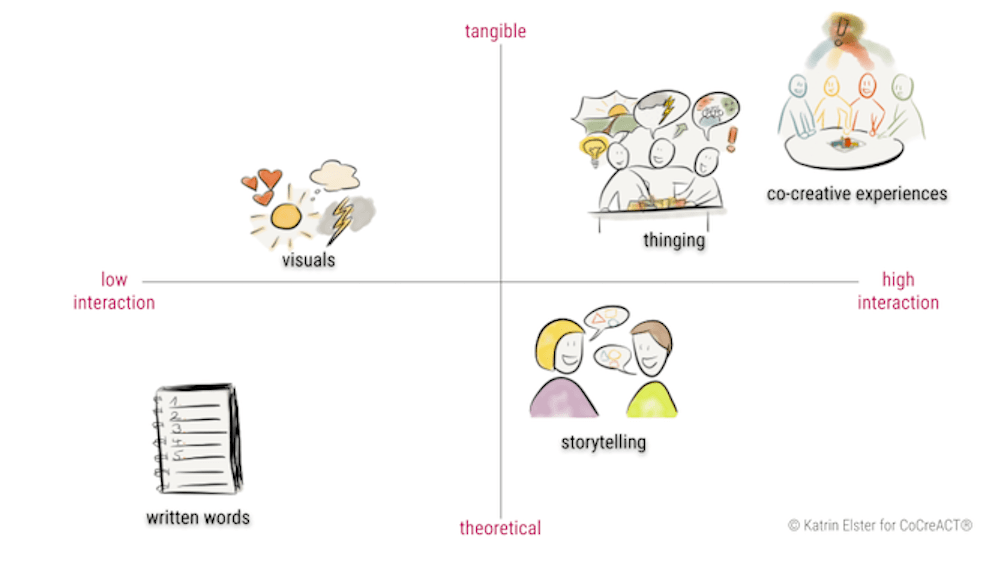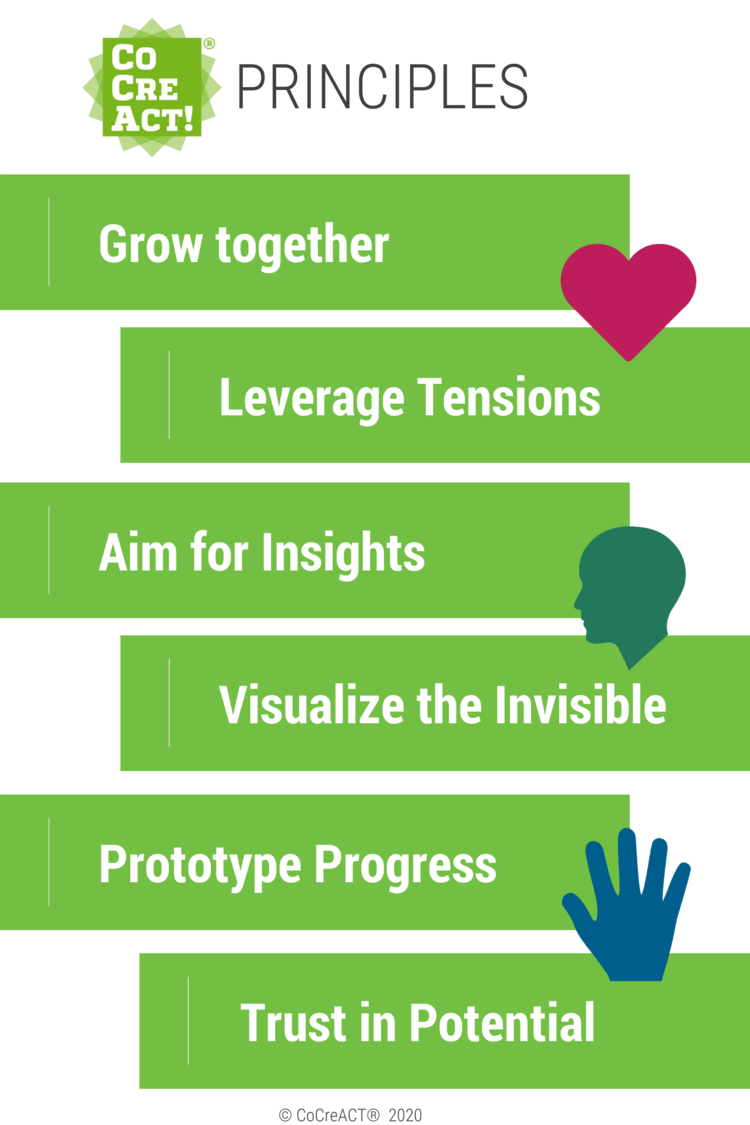Navigating Ambiguity (4/6): Visualize the Invisible
This is the 4th of a six-part series on our approach to navigating ambiguity based on six principles. Please find the others here.
How we shape the world we (want to) see
Humans are meaning-making machines. We like stories. They shape our thinking and our behavior.
If a story is missing any pieces our brain fills in the gaps of information, without us even consciously noticing. It aims to recognize patterns and establish certainty. It tries to fit new information into an existing “frame”. This is why we can’t simply rely on facts and ignore our frames.
In ambiguity, there are lots of missing pieces of information. We are in uncharted territory where, oftentimes, our existing frames don‘t fit. In the uncertainty of possibilities, we may get easily lost or overwhelmed. Only when we direct our cognitive attention to the multiple possibilities in an ambiguous situation, we can explore this room for new potential. Therefore, to avoid the feeling of overwhelm, it helps to have something to hold on to, something tangible that guides us along the path to the new worlds that we want to create. Sadly, adapting existing or creating new frames is hard work and demands different ways of thinking and doing.
When we want to focus on the possibilities in uncertainty, we have to make an extra effort to visualize the new ideas or a vision. We have to build a case for the new frame or thinking that we want to activate in people’s heads. We need to see and feel on the outside what we are imagining on the inside. We visualize the invisible.
Is it important to reflect and aim for insights? Yes! And... we need ways to communicate insights and ideas so that we can create new stories in our heads: When we express our intentions and thinking in a more tangible and experiential way, our brain feels more invited to join us on this mental adventure trip through ambiguity.
Visualize Your Thinking
See what we did there? We used a metaphor. Of course, a brain can’t pack a suitcase and go on a trip, but by using the adventure trip as a metaphor our brain was immediately more tempted to buy the ticket.
Metaphors are effective storytelling tools to get across abstract information in a way that engages our brain. They create mental shortcuts in our minds. It is easier for us to make connections and get looped into a way of thinking.
A more advanced way to get our message across is by using visuals. Currently, sketchnoting is a popular approach that people use to visualize complex information. Let’s admit it: nearly any way you can think of to visualize information - be it a storyboard, a graphic recording, or an illustration - is easier and more enjoyable to absorb than a Powerpoint slide filled with text!
The Museum of StrategicPlay®
The next step to communicate in a more brain-friendly way is through the use of artifacts. When we use interesting physical prompts to share information, people get curious. You can think of these artifacts as souvenirs of the imagination that remind us of the experiences we have made.
Katrin once had to deliver a pitch to win a contract. Of course, the client expected a “capabilities presentation” using slides. Instead, they were invited to visit a “museum” where Katrin served as the guide, leading them through an exhibition of how our team works and what we have to offer. This experiential adventure generated discussions and engagement that were more in-depth than a presentation. (And yes, it worked. That client was eager to start their adventure!)
Become a creative thinger
Beyond using visuals and artifacts, the next level of visualizing the invisible, is to let people interact with artifacts and give them meaning.
“Humans are organisms of a creative sort. We make new things that scaffold the ecology of our minds, shape the boundaries of our thinking and form new ways to engage and make sense of the world. That is, we are creative ‘thingers’.” writes Lambros Malafouris (University of Oxford) in his paper on “Creative thinging”. We will forever be grateful that he came up with this wonderful word: thinging, which describes the act of creating things with our hands that enable us to “shape the boundaries of our thinking and the ways we understand and encounter the world”.
LEGO® Serious Play® in Action (c) StrategicPlay®
One great example of thinging that we frequently use to help people envision the future is the methodology of Lego® Serious Play®. It offers unique ways to literally shape the thinking of a team as they collaboratively build their endeavor with their hands. People externalize their mental models and ideas in LEGO® models, filling the table with their story, building their shared vision and its ecosystem. They preserve and visualize the complexity of a situation and make it manageable. This process also gives the team new vocabulary and a shared language to talk about the world they want to create.
Every prototype that we build to show what we aim for, in Lego® Serious Play®, design thinking, or in architecture, helps us to visualize the information so that the audience can explore it to understand it. These multi-dimensional interactions reveal elements of an idea that would otherwise remain invisible if expressed only as words. What we can touch, use, and feel engages our senses, our brain, and our whole selves as creative thingers.
Design co-creative experiences
If you want to help people understand, help them feel. Emotions are a great vehicle for communicating the invisible. Why draw what you want to get across when you can act it out?
In ambiguous situations, co-creating the narrative offers unique potential. We use the diverse wisdom of the group. Shared experiences are a pathway to enter an emerging world, together. Getting the brain off the beaten path creates interactions that foster the emergence of the new and stimulates the flow of ideas. This enables everyone to think in new directions and embark on “cognitive offroading” together.
When we lead in ambiguity it is our responsibility to design opportunities for people to engage, use their creativity, and envision a shared direction. All you need to start is a nudge, an idea or a hope why this effort might be worth it and then hand it over and trust in the creativity of your peers.
The possibilities for co-creative experiences are endless: perhaps it’s a co-creative session where people build their thinking, an improv session, a role play, or an expedition. You can also try new team rituals to see if new behaviors inspire you to deal differently with a complex issue. The more experiential, the better.
Visualize the Invisible: Make your thinking experiential
Encourage for Ambiguity
Next time you want to encourage your team to tackle an ambiguous challenge, try to combine a visual, an artifact, and an experience. Instead of a meeting or presentation schedule a field trip or a show-and-tell. Yes, you can do these things virtually, too! Explore ways to avoid the meeting (and Zoom) room and go outside. Take the attention where the issue (or a solution for it) might manifest itself. Make it experiential!
Or you might start small and simply try to use words more wisely when in ambiguity. It’s possible to change emotions with a word. When we use nouns rather than verbs we have a higher chance of a calming effect. Nouns are more abstract. Actions are more likely to trigger emotions and generate energy to act. The next time you want to convince someone to join you in an ambiguous challenge, use nouns to address the issue. Make it easy for them to join you on the rollercoaster ride into ambiguity!
If you’ve missed our introduction about our principles to navigate ambiguity, please continue reading...
WHY PRINCIPLES TO NAVIGATE AMBIGUITY?
Now more than ever we need to adopt new ways of being. We need to find simple and powerful approaches to ambiguity that reveal the possibilities of new worlds. The key pillars of ambiguity activism that we outline in our CoCreACT® approach aim to do precisely that:
CoCreACT® Principles for Navigating Ambiguity
Co - new ways of feeling: We are in this together. Shared purpose gives us strength and direction and connection. Owning our collective uncertainty inspires us to deeper understanding and new perspectives.
Cre - new ways of thinking: In the unknown, our understanding and imagination must have fertile space to grow so that we can co-create new knowledge and solutions. This is only possible when we are able to communicate the ambiguous in experiential ways that foster compassion and creativity.
Act - new ways of doing: Trailblazing does not follow a straight and predetermined path, so we prototype forward. Our progress comes from iterative cycles of experimenting and learning. We can’t evolve through control, but through lifting each other up and being better together than we could ever be alone.
Developing an ambiguity activist mindset requires feeling, thinking, and doing in new ways. To illuminate the path forward, we have developed six essential principles for finding the big possibilities in ambiguity.




